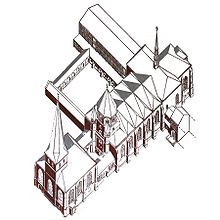St. Johann Baptist (Essen)
The Catholic Adoration Church of St. Johann Baptist is a Gothic hall church in the center of Essen , which stands prominently on Essen's main shopping street, Kettwiger Straße , and is in front of the Essen Minster Church .
history
The church emerged from a Johanneskapelle, which belonged to the Essen women's monastery in the 10th century . According to the will of Abbess Theophanu , who died in 1058, candles were to be lit ad sanctum Iohannem as part of her memoria , this is considered to be the first mention of the church. From the dedication of the church to Saint John the Baptist it is concluded that it was originally a baptistery . The ground plan of this chapel could be deduced from excavation findings after the Second World War. In 1264 the abbess Berta von Arnsberg elevated the chapel to a branch parish church of the monastery. Later on, the church served as a meeting place for the canons, who performed sacred acts reserved for men for the women of the monastery. The church was rebuilt in 1471 as a Gothic hall church and extended by a rectangular east choir. From 1699 to 1768 there was a baroque interior. Choir stalls, side altars and a pulpit were purchased. The pulpit was replaced in 1769 by one in the Rococo style.
The church was restored in 1887. Before that, the last Roman Catholic service was held on November 12, 1876 by Pastor Peter Beising . After the Old Catholics had used the Pauluskirche , they now moved to the St. John's Church. In 1914 they received their own church building with the Friedenskirche .
In 1968 the church of St. Johann Baptist was renovated and given a new color. The almost square floor plan of the building encloses a structure of new room compartments. Two yokes of a three-aisled late Gothic hall, the square choir and the southern side choir, as well as the northern passage room with the organ gallery. In the hall, the ship's widths change from uniformity in the west via trapezoidal transitional parts to a choir bay. The even west yoke is actually a tower yoke, which cannot be seen in the interior because the mass of the massive tower, crowned with a high pointed helmet, is derived from free pillars without changing the vault height.
Today the church serves as a worship church and parish church for the Catholic community in downtown Essen.
Main altar by Bartholomäus Bruyn the Elder
The baroque main altar of the church, originally a side altar of the minster, as well as four altar panels, which were made by Bartholomäus Bruyn the Elder between 1522 and 1525 for the main altar of the minster, are significant in art history . The paintings are major works by Bruyn of the highest artistic quality. The life path of Jesus is shown. The panels are painted on both sides so that the crucifixion is on the back of the nativity and the descent from the cross is on the back of the Adoration of the Magi. Therefore, only two images are visible at a time. What is remarkable about the depiction of the Descent from the Cross is that in the background a central European city is depicted instead of Jerusalem. This city is the oldest pictorial representation of the city of Essen with the Steeler Tor and the former Essen city wall .
Views of the altar
Bells
The bell of the church consists of three bells , all of which date from 1787 and, due to their importance, were spared when the bell was donated for war armor in 1917. In 1940 the bells were confiscated for military armor, but not melted down. All three bells bear the inscription "Henricus et Everhardus Petit me fuderunt anno 1787", which they identify as the work of the Bell foundry Petit & Gebr. Edelbrock, which still exists in Gescher today . The 669 mm in diameter es 2 bell bears no further inscription, the 995 mm in diameter as 1 bell is “St. Johannes Baptista ”, the 790 mm diameter c 2 bell with“ St. Johannes Evangelista “. The invoices of the monastery show that in 1787 these cost a total of 1687 Reichsthaler 7 Stuber, of which 1173 Thaler 24 Stuber were paid in cash, for the rest the founders took the old bells of inferior quality in payment. All bells are added to the ringing of the cathedral and also sound together.
literature
- Heinz Dohmen : Adoration Church of St. Johann-Baptist, Essen . In the S. (Ed.): Image of the sky. 1000 years of church building in the diocese of Essen . Verlag Hoppe and Werry, Mülheim an der Ruhr 1977, pp. 24-27.
- Paul Clemen : The art monuments of the city and the district of Essen (= The art monuments of the Rhine province, Vol. 2, 3). Schwann, Düsseldorf 1893, pp. 55-56 ( digitized version ).
Individual evidence
- ^ T. Kellen: The industrial city of Essen in words and pictures. History and description of the city of Essen. At the same time a guide through food and the surrounding area. Fredebeul & Koenen, Essen 1902, p. 72, 73 .
- ↑ Heinz Dohmen: Adoration Church of St. Johann-Baptist, Essen . In the S. (Ed.): Image of the sky. 1000 years of church building in the diocese of Essen . Verlag Hoppe and Werry, Mülheim an der Ruhr 1977, pp. 24–27, here p. 26.
- ↑ a b c Excerpt from the Glockenbuch Essen, pages 62, 63 ; accessed on January 20, 2018
Web links
Coordinates: 51 ° 27 ′ 21 ″ N , 7 ° 0 ′ 47 ″ E







